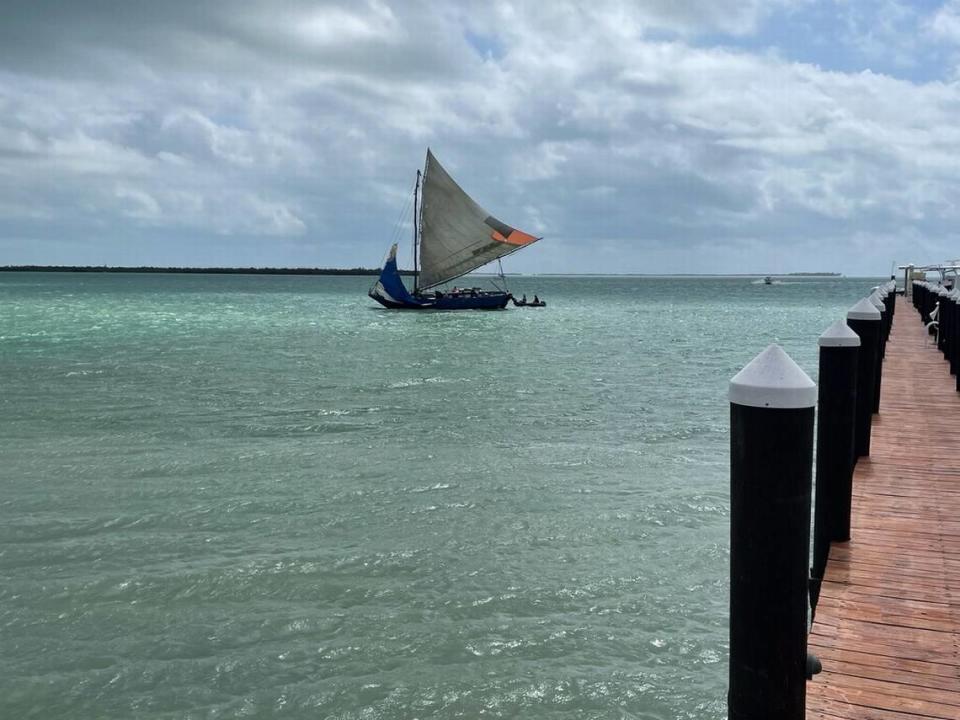More than 100 Haitian migrants land in Florida Keys, gather in yard of oceanfront home
For the second time in two weeks, a large group of Haitian migrants has come to shore in the Florida Keys.
Monroe County Sheriff Rick Ramsay said 100 to 150 people arrived in a sailboat Monday morning off Summerland Key, about 20 miles from Key West.
Photos provided by the sheriff’s office show a large group of people gathering in the yard of an oceanfront home on Summerland Key.
It is unclear whether the boat came directly from Haiti or elsewhere in the Caribbean. But last week, a source in Haiti who monitors maritime migrant operations told the Miami Herald that two boats had left the country’s northwest coast on Tuesday and more were scheduled to leave over the weekend. All were bound for the Florida shorelines, the source said.
Read more: New trafficking routes bring migrants to Ocean Reef resort, other Keys spots
In addition to Florida, they are also arriving in Puerto Rico. U.S. Customs and Border Patrol in the U.S. territory has processed 571 Haitians since October. The majority of them are landing on Mona Island, followed by mainland Puerto Rico.
“When we look at the migration map there is always a peak at high levels of political instability and grave human rights abuses in Haiti,” said Marleine Bastien, a Haitian advocate and founder of Family Action Network Movement in Miami. “It never fails.”
Bastien said the boats will keep coming as long as conditions in her crises-wracked homeland continue to deteriorate.
“Haitians are at war. They are under constant assault, and the reason why we haven’t seen a greater amount of people fleeing for their lives is because our people have a lot of courage, they are used to misery,” she said. “We are a people of resilience, people who have been dealing with it so long and we have the highest capacity to endure.”
Prior to Monday’s landing, four overloaded rickety boats arrived in the Florida Keys from Haiti since November, ferrying nearly 700 Haitians trying to escape worsening conditions.
While the Keys are a common landing spot for Cuban migrants, whose numbers are also on the rise, the island chain has not been a frequent end point for Haitians. But their arrival there suggests that human smugglers are becoming better organized and sophisticated in their methods as they seek to reach U.S. soil.
The fact that they’re ending up in the Keys also points to new migration routes, likely using the coastlines and territorial waters of Cuba en route to South Florida in order to evade U.S. Coast Guard cutters stationed between the U.S. and Haiti. The Keys are just 90 miles from Cuba.
Already in the throes of deepening political, economic, humanitarian and gang crises prior to last July’s assassination of President Jovenel Moïse, Haiti is seeing conditions worsen. Five weeks after Moïse’s killing, a magnitude 7.2 earthquake struck the country’s southern peninsula and left more than 2,000 dead. A rising tide in gang violence and ongoing political instability have made it difficult to provide assistance, as well as improve security and the economic situation throughout the country.
On the same day that the migrants arrived in the Lower Keys on Monday, doctors throughout Haiti began the first of a three-day work stoppage to protest the March 2 kidnapping of two of their colleagues. Urologist Pierre Boncy and obstetrician-gynecologist Michel D’Alexis were grabbed from inside their medical practice in Port-au-Prince by armed people wearing Haiti National Police uniforms, and remain captive nearly two weeks later.
The strike was launched by the Haitian Medical Association and other health professionals, who are demanding that the interim government led by a fellow physician and neurologist, Prime Minister Ariel Henry, take measures to restore security in the country. The strike’s announcement came on the heels of another work stoppage, this one by the State University of Haiti after the recent assassination of one of its professors, Jacques Faubert Etienne.
Last week, a U.S. Coast Guard cutter arrived back in the northern Haitian city of Cap-Haïtien with 198 repatriated Haitian migrants. Those disembarking repeatedly cited gang-related violence and kidnapping as the reasons behind their decision to flee, as well as the lack of job opportunities in the country.

The group was among 356 people who arrived from Haiti on March 6 in a cargo freighter that ran aground off Ocean Reef Club, a gated community and resort in Key Largo in the Upper Keys; 158 migrants dropped into the ocean and swam about 200 yards to shore. Late last week, they were being screened for credible fear that might lead to successful asylum claims, according to U.S. Customs and Border Protection.
However, their current location remains unclear. During a protest Saturday, Haitian and immigration advocates gathered in the rain outside of a Border Patrol office in Dania Beach demanding access to the migrants in order to alert them about their rights. Their pleas, however, went unheard. The office was closed, and the migrants’ whereabouts remain unknown.
“People are desperate for answers,” said Bastien, one of the organizers of the protest. Bastien said family members have flooded her phone lines seeking answers about loved ones who they believe were traveling on the boat.
Unlike in years past when arriving Haitian migrants were sent to the Krome Detention Center in South Miami-Dade County or the Broward Transitional Center, detained Haitian migrants are being distributed to detention centers around the country, some as far away as Texas. In order to track them, individuals need to have their names.
Miami Herald immigration reporter Syra Ortiz-Blanes contributed to this report.

